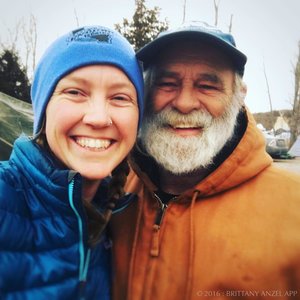An Interview with Brittany Anzel App

At Ecologistics, we are excited to be sponsoring the work of local story-teller, photographer, and documentary filmmaker Brittany Anzel App. I recently had the opportunity to speak over the phone with Brittany to discuss her latest project, ‘Where There Once Was Water’, a feature length documentary exploring California’s water crisis.
My conversation with Brittany inspired a range of vivid personal memories related to water as we talked: an excursion to Kings Canyon National Park to experience crystalline sheets of ice melt flowing over polished granite- at Mist Falls; seeing Roberto Monge speaking at last year’s Ecologistics Deep Ecology Collaboratory, who praised the heroic efforts of “Water Protectors” at the Standing Rock Dakota Access Pipeline Protests; reading passages from a book (In Praise of Nature) by Bioregionalist Stephanie Mills that beautifully described the mysterious qualities of H2O.
Seeing the sneak-preview of Brittany’s new documentary, ‘Where There Was Once Water’, expanded my awareness of the threats to California’s increasingly broken water cycle. These threats are manifesting in changing weather patterns from climate change, depleted salmon runs from excessive damming of rivers, soil erosion from industrial farming techniques (“water follows carbon”: we should be preserving the carbon in the soil instead of pumping it into the sky), and severely tapped-out aquifers.
All this recalled Marc Reisner’s book, Cadillac Desert, especially where he details the collusion of monied interests, western politicians, and government agencies like the Army Corps of Engineers and Bureau of Reclamation. The Central Valley Project (CVP) is a perfect illustration of the problem- a boondoggle that continues to bring cheap, federally subsidized water to a relatively few industrial agriculture and cattle ranching interests. The upshot here is a politically and environmentally toxic situation: ongoing water subsidies to some of the wealthiest corporate farmers in the country in return for massive selenium-laden salts as agricultural runoff polluting waterways from the San Joaquin Valley to the delta of San Francisco Bay.
We talked about the politics and environmental impacts resulting from the extensive damming of California’s wild rivers (Wikipedia lists over 1400 named dams & 1300 named reservoirs for the Golden State). Brittany focuses on the proposed Temperance Flat Dam in her documentary to illustrate the controversy that swirls around any proposed dam these days. In the film, she interviews Daniel P. Beard, former Commissioner of the U.S. Bureau of Reclamation and author of Deadbeat Dams: Why We Should Abolish the U.S. Bureau of Reclamation and Tear Down Glen Canyon Dam, who cautions against following the same worn-out strategies as relying on dams to solve our water needs. Beard points instead to “the thousand different things” we could be doing in the way of water conservation, re-use, and efficiency. Instead, according to a Friends of the River study, the proposed TFD plan would be “a net energy loser”, while having “long-term unavoidable adverse impacts on riverine fisheries and their habitat, botanical resources and wetlands, wildlife and wildlife habitat, cultural resources, recreation, and scenery. Up to 5,000 acres of public land would be flooded by the dam, adversely impacting 11 known and 19 possible sensitive, threatened or endangered wildlife species. The reservoir would also drown several miles of trails popular for public recreation and used for Native American cultural interpretation and outdoor education in the scenic San Joaquin River Gorge.”
One of the aspects of ‘Where There Once Was Water” that resonated most strongly for me was Brittany’s decision to incorporate the Standing Rock protests of the Dakota Access Pipeline http://standwithstandingrock.net/category/news/ into her documentary. I had closely followed the evolution of events in North Dakota and looked forward to hearing Brittany’s perspective from the front lines. She had been impressed by the courage and spiritual commitment of the water protectors. Some of the hostility and over-the-top militarized weaponry she saw from law enforcement had made quite a powerful impact on her.
I commented that I had seen her interview at the camp with water activist John Wathen https://vimeo.com/194193680, who said the police actions at Standing Rock were “the most lawless operation by law enforcement that I have ever been a part of in my life.” He had also been present during the battle for civil rights in Birmingham, Alabama in 1963 and said that what he saw from police at Standing Rock was as bad- if not worse.
One of the reasons why the police response at Standing Rock was so troubling was the overreaction of North Dakota’s Governor Jack Dalrymple in declaring the DAPL protest a state of emergency, which allowed utilization of the Emergency Management Assistance Compact (EMAC). The EMAC statute is normally employed in the wake of natural disasters, but it can also be used in “community disorders, insurgency, or enemy attack.” Standing Rock was one of the few times when EMAC has been called on to respond to peaceful political protest. The Standing Rock water protectors had to confront not only the local Morton County Sheriff’s Department, but police departments from 24 counties and 16 cities in 10 different states. We may see more confrontations with militarized police in the coming months as citizens gather to protest the desecration of public lands in the Trump era.
‘Where There Once Was Water’ recently played to a sold-out crowd at the Octagon Barn in SLO as part of the 2017 San Luis Obispo International Film Festival. Look for Brittany’s feature-length film to be released in the Summer of 2018. Check out her websites: http://www.wherethereoncewaswater.com and https://www.appsphotography.com/. Thank you, Brittany, for the important work you are doing to raise awareness of our need to change the ways we use (and THINK) about water in California and other regions of our blue planet.




Been compiling information on water restoration measures.
Michal Kravtich, Sepp Holzer, PA Yeomans, Brad Lancaster, etc.
Patty Ridenour with the Geography Dept at Ventura College who wants to screen movies on campus may be able to host a screening.
http://www.goodtravelz.org
http://www.dietrickinstitute.org
http://www.rinconvitova.com
http://www.artizenschool.com
Cheers-
Brett
Thanks, Brett. I’ll get this info to Brittany.